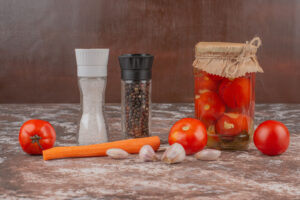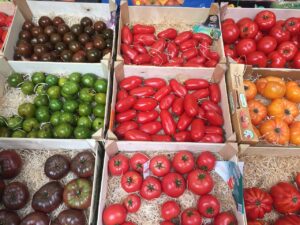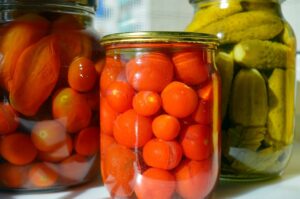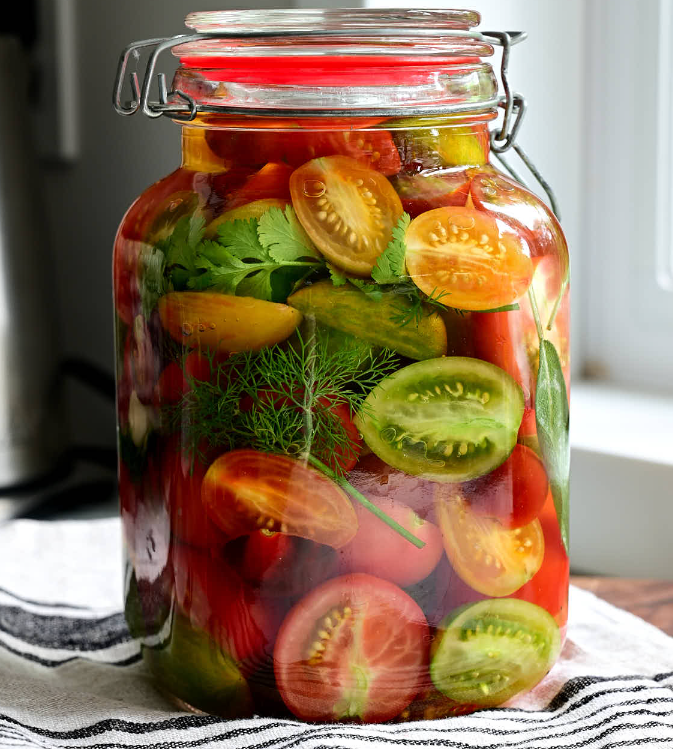Pickling is a great way to preserve your tomato harvest and add some zest to your meals. Whether you’re new to pickling or want to try a new recipe, this guide will show you how to pickle tomatoes at home step by step.
Step-by-Step Guide to Pickling Tomatoes
When you’re ready to pickle tomatoes at home, you’ll need fresh tomatoes, vinegar, spices, and mason jars. Follow the instructions to ensure your tomatoes are perfectly pickled, giving you a delicious treat that can last for months!
Benefits of Pickling Tomatoes
Pickling offers numerous benefits, especially when you have an abundance of tomatoes from your garden. Here’s why pickling tomatoes is a great idea:
- Preserve your harvest and reduce food waste
- Add a tangy, flavorful twist to salads, sandwiches, and snacks
- Prolong the shelf life of your tomatoes for up to 6 months
- Enjoy a quick and easy way to store tomatoes without freezing or canning
If you’re also interested in preserving other crops, you might enjoy reading this Ultimate Guide to Pickling, which covers everything you need to know about pickling all kinds of produce.
Tools and Ingredients Needed

Before you start, gather these essential tools and ingredients for the pickling process:
- Mason jars and tight-fitting lids
- Vinegar (white or apple cider vinegar work best)
- Spices and herbs: Dill, garlic, peppercorns, mustard seeds, chili flakes
- Sugar, salt, and water
- Fresh tomatoes: cherry, plum, or green tomatoes
For more tips on safe canning practices, check out this resource from Ball Canning.
Step-by-Step Guide to Pickling Tomatoes

Follow these simple steps to pickle your tomatoes:
- Prepare the Tomatoes: Wash your tomatoes and remove any stems. If you’re using cherry or small tomatoes, leave them whole. For larger tomatoes, cut them into halves or quarters.
- Make the Pickling Brine: In a saucepan, combine 1 cup of vinegar, 1 cup of water, 2 tablespoons of sugar, and 1 tablespoon of salt. Bring to a boil until the sugar and salt dissolve.
- Add Herbs and Spices: Place garlic cloves, dill sprigs, and your favorite spices into the bottom of your mason jars. This adds flavor and depth to the pickling liquid.
- Pack the Tomatoes: Carefully pack your tomatoes into the jars, leaving about half an inch of space at the top.
- Pour the Brine: Pour the hot brine over the tomatoes, ensuring they’re fully submerged. Seal the jars tightly.
- Let Them Cool: Allow the jars to cool at room temperature before placing them in the refrigerator. Your pickled tomatoes will be ready in 48 hours but are best after a week.
Quick Pickling vs. Traditional Pickling
- Quick Pickling: Ready in just a few days, quick pickling is great for short-term use (up to 2 months in the fridge).
- Traditional Pickling: This method involves canning and a longer fermentation process, giving the tomatoes a deeper flavor. The shelf life is longer, up to 6 months.
Common Mistakes to Avoid
- Over-salting: Too much salt can overpower the tomatoes. Stick to the recipe ratio.
- Under-salting: Not enough salt will lead to bland pickles.
- Not sterilizing jars: Always sterilize your jars to prevent contamination.
- Using overripe tomatoes: Only use fresh, firm tomatoes for pickling to avoid mushy results.
Flavor Variations and Add-ins
Here are some ways to get creative with your pickling process:
- Spicy Pickled Tomatoes: Add chili flakes or fresh peppers for extra heat.
- Sweet and Tangy Pickled Tomatoes: Increase the sugar to 4 tablespoons for a sweeter brine.
- Herb-Infused Pickles: Add rosemary, thyme, or oregano to give your pickled tomatoes a Mediterranean twist.
Storage and Shelf Life

Pickled tomatoes can be stored in the refrigerator for up to 2 months. If you’re canning them using the traditional method, they can last up to 6 months on the shelf. Be sure to check for signs of spoilage like mold or an off smell before eating.
Recipes Using Pickled Tomatoes
Here are a few creative ways to enjoy your pickled tomatoes:
- Pickled Tomato Salad: Toss them into a fresh salad with feta cheese and olives.
- Pickled Tomato Sandwiches: Add them to your sandwiches for a tangy crunch.
- Pickled Tomato Pasta: Chop them up and mix into pasta dishes for extra flavor.
Nutritional Information
Pickled tomatoes retain many of the nutrients found in fresh tomatoes, including vitamins A, C, and potassium. They are low in calories and can be a healthier alternative to sugary or processed snacks. Plus, vinegar-pickled tomatoes may aid digestion due to the probiotics formed during fermentation.
FAQs
What type of tomatoes are best for pickling?
Cherry and plum tomatoes are ideal due to their firm texture, but green tomatoes work well too.
How long should you let tomatoes pickle before eating?
Pickled tomatoes are ready in 48 hours, but for the best flavor, wait at least 1 week.
Can you pickle tomatoes without vinegar?
Yes, you can ferment tomatoes without vinegar, but the process takes longer and results in a tangier flavor.
What is the shelf life of pickled tomatoes?
Pickled tomatoes last up to 2 months in the refrigerator, or 6 months if canned.
Can you reuse the brine for another batch of tomatoes?
Reusing brine is not recommended, as it may lose its potency and lead to spoilage.
By following these simple steps and incorporating your favorite flavors, you can pickle tomatoes at home with ease. Pickling is a fantastic way to preserve your garden’s bounty and add some zest to your meals! 🌿🍅
